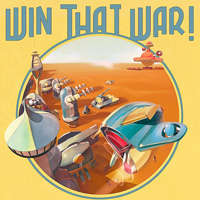
Win That War!
Release Date: cancelled
Strategy, science fiction, RTS, MMORTS, online, indie games, MMO, internet, LAN
Steam
A rare example of an MMORTS game set in a retro-futuristic universe. Developed by a French independent studio – Insane Unity – Win That War! combines the gameplay mechanics typical of real-time strategy games with online interactions. The game allows the players to choose a side in a war between three megacorporations, which fight against each other for control over newly discovered planets full of precious minerals.
Win That War! is a PC strategy game, which combines elements of RTS and MMO and implements them into a retro-futuristic setting. The game has been developed and published by an independent studio from France – Insane Unity.
Before its official release, Win That War! was presented on many festivals, as well as video games and science-fiction conventions (French Stunfest, Art2Play, Utopiales, and the British EGX Rezzed). The game also participated in the Steam Greenlight program.
Plot
In Win That War! the action takes place in the year 1023 of the Galactic Era. The explored regions of space are under control of 3 powerful megacorporations: ATLAS, Jet Blum, and N.A.S.C.A. While members of exploratory missions discover previously unknown planets filled with precious minerals, the economic giants begin a race to seize control over these new planets. Robotic armies – consisting of tanks, aerial units, and powerful command centers – are dispatched to planets’ surfaces to secure the interests of the megacorporations.
Mechanics
The PC release of Win That War! combines typical RTS and MMO elements. The most prominent among the game modes is the Galactic Campaign, in which hundreds of players can wage grand battles for control over given planets. Each player represents one of the three available factions. The battles themselves feature mechanics typical for RTS games: after selecting a planetary sector from the orbital view, players are transferred onto a 3D battlefield, where they can build bases, acquire resources, recruit units, and fight the enemy.
For each victorious battle, a player is rewarded with funds he can invest into recruiting new armies. Having many combat teams allows players to dispatch them into a number of different planetary sectors, where they want to operate. The unsupervised divisions will secure the given faction’s control over the territory and defend it from players representing other corporations. If enemy players decide to attack, the AI leads our army.
Alternatively, players can spend their funds on improving their, already existing, army. The Upgrade Tree allows players to choose the preferred direction of technological development. Unlocking the aerial vehicle factory opens new options, like recruiting bomber and fighter squadrons, while the Demolition Lab build provides players with artillery units. Taking the defensive technology path allows players to build strong walls with long-range cannons around their bases.
When fighting for control over a given planetary sector, the player’s main goal is to eliminate the enemy command unit. Each player has one of these – they ensure the primary energy level and are necessary for other structures to be built in the region. Whenever a player loses their commanding unit, they immediately lose the battle since all their structures and dispatched units are set to self-destruct. There are 3 types of command units: the Sentinel, the Excavator, and the Outpost. The Sentinel has a powerful laser cannon able to defend the base from weaker units. The Excavator generates resources on his own. The Outpost offers a better energy generator and increased range, in which one can build structures.
The basic structures one can build are the resource generating buildings. Apart from the energy generated by the base, the game features 2 kinds of resources: Sharp Crystals and Glowing Fluid. Crystals are the basic resources, while the liquid allows players to create more advanced units such as airplanes. Factories produce units and right away inform the player of these units’ purpose in battle. In most cases, the game does not use fancy names – vehicles have simple names, like the light tank, the fighter, and the bomber. An exception to this rule is the Diplomat scouting unit. There is also the Engineer unit, responsible for building structures.
What is worth mentioning, both in multiplayer and single-player modes the maps are generated procedurally. Players can significantly zoom out in order to make a tactical reconnaissance.
Game modes
The main attraction featured by Win That War! is the Galactic Campaign, in which players fight each other to take control over particular planetary sectors. Battles are waged in a typical RTS manner, taking place in selected regions of the beleaguered planet. Whenever a players logs out of the game, he entrusts his army to the AI.
Additionally, players can play online battles against each other.
In the single player quick game mode one can test his skills against the AI, right after selecting the type of terrain on which the battle will take place, the AI difficulty level and the type of command unit.
The game also has a tutorial, which provides beginners with rules on how to play.
Technical aspects
The visuals of Win That War! are held in a retro-futuristic style. The round shape of vehicles and structures were inspired by a future predicted by the futurologists of the 1950s. The 2D models of the space vehicles remind one of the reality presented in an animated TV show: the Jetsons. The entire experience is accompanied by a suitable soundtrack, written by a rock band called Bikini Machine.
Last updated on July 5, 2017
Videos and Screens
Win That War! Summary
Platforms:
PC Windows
Developer: Insane Unity
Publisher: Insane Unity
Age restrictions: none